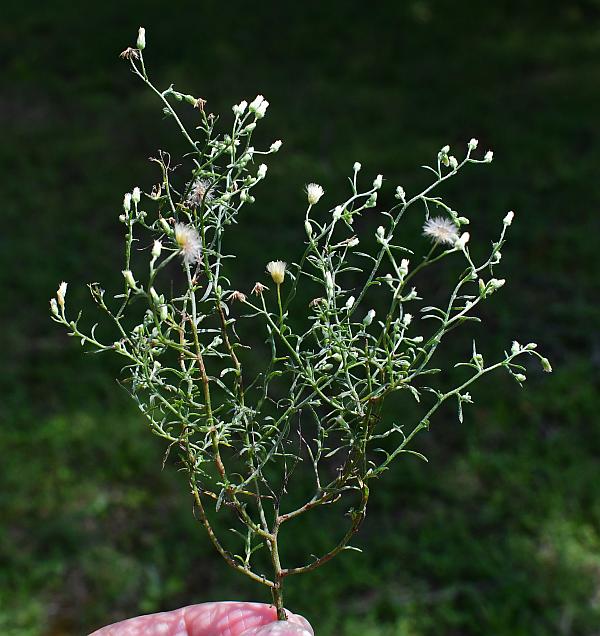Conyza ramosissima Cronquist
Dwarf Fleabane

Native
CC = 1
CW = 5
MOC = 48
© SRTurner
Conyza ramosissima CronquistDwarf Fleabane | |
 |
Native CC = 1 CW = 5 MOC = 48 |
© SRTurner |
|
Family - Asteraceae/Astereae Habit - Annual taprooted forb. Stems - Spreading, sometimes with ascending tips, to 25 cm, usually highly branched, conspicuously pubescent with antrorse white hairs, the plant thus appearing canescent.
Leaves - Alternate, simple, entire, sessile, 0.5-2.5 cm long, narrowly linear, moderately to densely appressed-hairy.
Inflorescences - short panicles, often dense and well developed but sometimes appearing as short racemes or loose clusters at the branch tips.
Heads - Radiate but very inconspicuously so. Involucre 1.5-3.0 mm long, narrowly cup-shaped or slightly bell-shaped or urn-shaped. Involucral bracts in 2-4 unequal, overlapping series, narrowly lanceolate to linear, the tip ascending, with a slender to relatively broad, green or brown central stripe, and with relatively slender, thin, pale margins, glabrous or sparsely appressed-hairy. Receptacle flat or nearly so, relatively smooth.
Ray flowers - 18-30, pistillate, the ligule pale pink to light purple. Disk flowers - 3-8, perfect, yellow. Fruits - Achenes 1.0-1.5 mm long, narrowly oblong in outline, flattened, the angles usually with inconspicuous nerves, the surface usually sparsely to moderately and minutely hairy, light tan to pale grayish brown.
Flowering - May - September. Habitat - Fields, pastures, prairies, glades, lawns, sidewalks, roadsides, railroads, open disturbed areas. Origin - Native to the U.S. Lookalikes - None. Other info. - This low, nondescript species is often missed or ignored, having an appearance which is the very antithesis of showy. It occurs throughout Missouri but is probably undercollected. Beyond Missouri it range is predominantly within the Midwest. It normally looks nothing at all like its sibling Conyza canadensis, which is typically tall and erect rather than low and extensively branched. However, C. canadensis is highly variable, sometimes flowering when only a few inches high, and the flowering heads of the two plants are very similar. A key character for identification are the strongly appressed, forward-pointing white hairs on the stems of C. ramosissima, which will clearly differentiate this species from any specimens of C. canadensis which may have been forced into a low, branched habit due to mowing. These hairs lend a grayish cast to the entire plant. Photographs taken at the Kansas City Zoo, 7-12-99, and in St. Louis, MO., 7-28-03 (DETenaglia); also near the Missouri Botanical Garden's Monsanto Building, St. Louis, MO, 7-23-2015, and at Shaw Nature Reserve, 8-12-2020 and 8-21-2021 (SRTurner). |